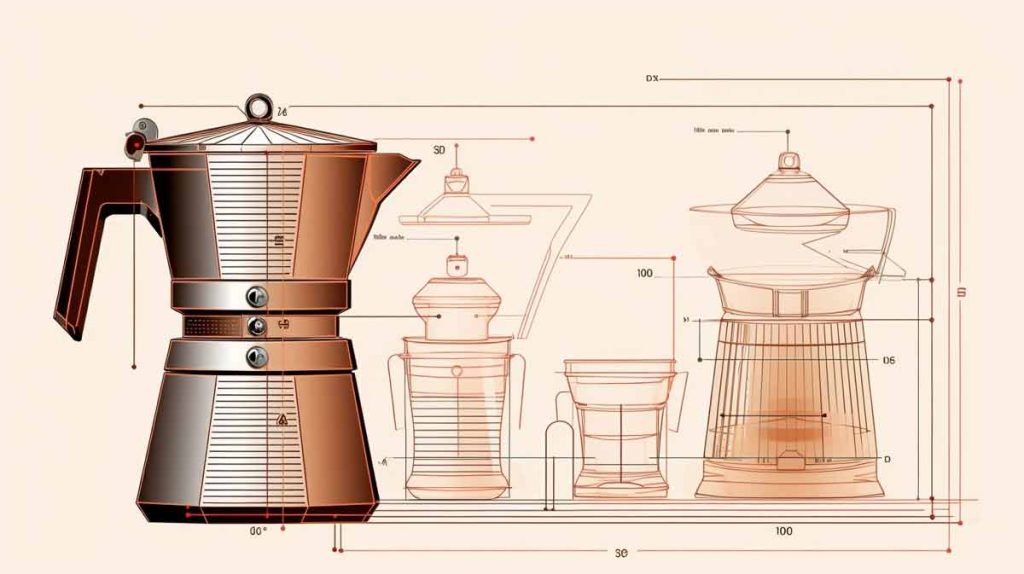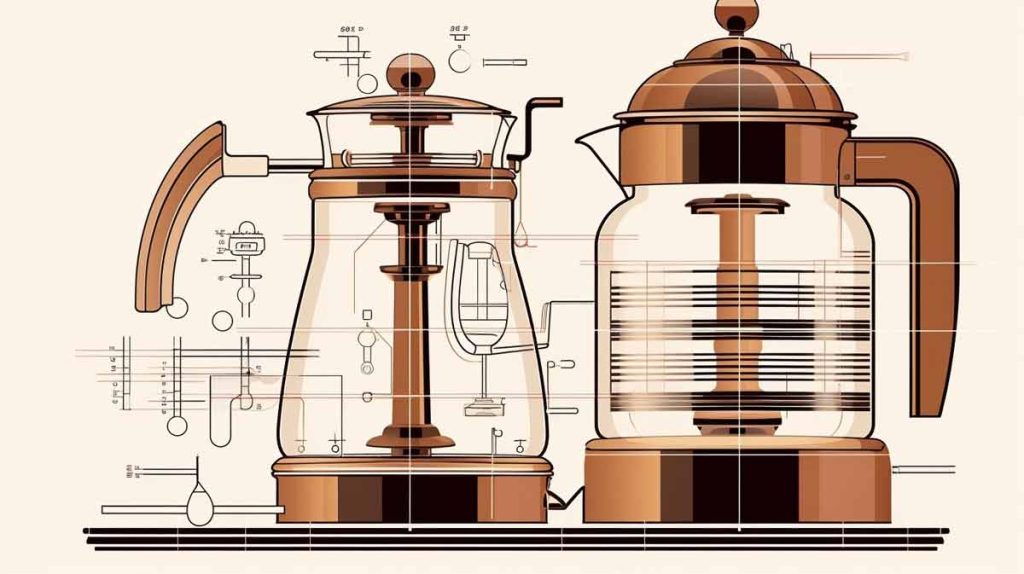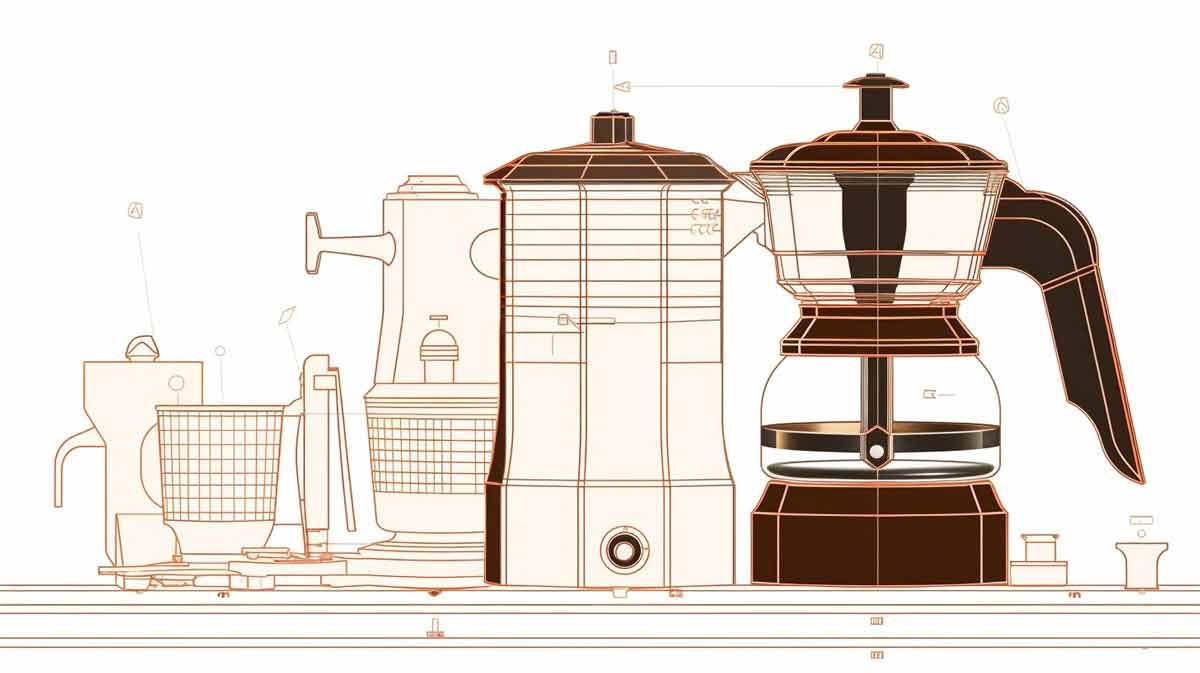Choosing between a Moka pot and a percolator can be like solving a coffee problem.
While both have been stalwarts in traditional coffee brewing, they offer distinct flavors and experiences.
This article aims to demystify these two classic devices, giving you an insightful comparison from design to taste profile.
Understanding the Moka Pot: A Deep Dive

The Moka pot is a stovetop espresso maker with a unique design and brewing process that produces strong and flavorful coffee.
Overview of Design and Construction
The Moka pot, often deemed the stovetop espresso maker, is an icon of Italian design.
Devised in 1933 by an engineer named Luigi De Ponti and marketed by Alfonso Bialetti, its elegant structure comprises two main components: a bottom chamber to hold water and an upper compartment for brewed coffee.
Separating these sections is a small filter basket that holds finely ground coffee.
The body of the Moka pot is typically made from polished aluminum or stainless steel, giving it durability and a charming vintage aesthetic.
In terms of construction, the magic begins when heat from your stove creates steam in the lower chamber, which drives pressure upwards through the deliciously packed fine grounds nestled in between- thanks to physics!
This pressure extraction method combined with a direct heat source produces concentrated coffee similar to espresso – though not quite meeting industry specifications for authentic espresso.
Nonetheless, it gives you a bold brew, exposing the depth of flavor and aroma otherwise lost in other home-brewing methods.
The Brewing Process of Moka Pots
The brewing process of a Moka pot is an art that transforms specialty coffee grounds into a delicious, caffeine-filled treat.
- Start by filling the bottom chamber of your Moka pot with cold water up to the valve.
- Place medium-ground coffee into the filter basket without tamping it down.
- Assemble the top and bottom sections of the Moka pot securely.
- Place your assembled Moka pot on a direct heat source, typically a stovetop, to ensure safety.
- With pressure extraction at work, the heat forces water vapor upward through the coffee puck in the filter basket.
- The heated water picks up essential oils and flavors from finely ground coffee as it rises to form concentrated coffee in the upper chamber.
- As deliciously aromatic espresso-like liquid fills your upper chamber, remove your Moka pot from the heat before it gurgles.
- Serve immediately for the best flavor and to enjoy your homemade espresso-like brew at its highest quality.
Flavor Profile of Moka Pot Coffee
Bursting with rich, full-bodied flavor, Moka pot coffee brings you closer to an espresso-like experience at home.
The unique pressure extraction method employed by the Moka pot ensures that every ounce of taste is squeezed out from your choice of specialty ground coffee.
This gives life to a concentrated coffee brimming with depth and intensity in each sip.
While it doesn’t produce authentic espresso or the characteristic ‘crema’, the output is spectacular for stovetop brewing methods.
These high-pressure stovetop espresso makers deliver a potent brew that fans call ‘faux espresso’.
Notably, this bold flavor profile appeals significantly to those who relish strong coffee and has a remarkable depth of flavor derived from their darker beans.
It’s worth noting, though; execution is critical here – grind quality can significantly affect the final outcome; coarser grinds may lead to under-extraction, while too fine can cause over-extraction and bitterness.
Advantages and Disadvantages
The Moka pot, often described as the stovetop espresso maker, offers unique benefits and drawbacks.
Here’s a detailed breakdown explained in a table format.
| Pros | Cons |
|---|---|
| Moka pots make concentrated coffee in one brew cycle, providing a taste closer to home-brewed espresso. | The coffee taste from a Moka pot is not exactly like espresso as Moka pots don’t generate the same pressure as espresso machines. |
| The coffee taste from a Moka pot is not exactly like espresso, as Moka pots don’t generate the same pressure as espresso machines. | Moka pots extract coffee below boiling point. If not monitored carefully, coffee can taste burnt or over-extracted. |
| Moka pots are ideal for coffee connoisseurs who want to explore different flavors and experiment with different beans. | Their brewing process is not as straightforward as that of percolators, making it more time-consuming and complicated for beginners. |
| They are durable and affordable, making them a good investment for coffee enthusiasts who enjoy the process of brewing their own coffee. | Moka pots require immediate use after brewing which might not be ideal for those who prefer to keep their coffee warm for longer periods. |
Depending on your brewing preferences and coffee tastes, these pros and cons can influence your decision.
Make sure to weigh them properly to choose the best fit for your needs.
Understanding the Percolator: A Detailed Look

This section will look closely at percolators and delve into their design, brewing process, taste profile, and pros and cons.
If you’re curious about the nostalgic charm of percolator coffee or are considering adding one to your coffee arsenal, keep reading for all the details.
Design and Construction
Percolators are designed with simplicity and durability in mind. Made from materials like stainless steel or polished aluminum, they have a classic and timeless look.
The construction consists of a lower chamber where water is placed, an upper chamber that holds the coffee grounds, and a tube that connects the two chambers.
Some also have a clear knob on top to see the coffee brewing process.
Unlike Moka pots, which require direct heat from stovetops, percolators can also be used on electric stoves, making them versatile for different kitchen setups.
Percolators are sturdy devices that withstand regular use and produce strong coffee batch after batch.
Percolators work by using steam pressure to extract flavor from the ground coffee.
As boiling water vapor rises through the tube into the upper chamber, it passes over and through the coffee grounds multiple times, thanks to gravity pulling it back down again.
This continuous circulation allows for maximum flavor extraction and creates a distinctive taste profile that is more similar to drip coffee than traditional espresso.
You control brew strength with percolators by adjusting grind size and brew time during each cycle.
The Brewing Process of Percolators
A percolator brews coffee by circulating hot water through the coffee grounds.
Here’s how it works:
- Grounds and Water: Coarse coffee grounds are placed in a filter basket, while water is added to the lower chamber of the Percolator.
- Heat Source: The Percolator is placed on a direct heat source, such as a stove or campfire.
- Boiling Point: As the water in the lower chamber heats up, it eventually reaches boiling point.
- Percolation Cycle: Once boiling, the hot water rises through a tube from the lower chamber to the upper chamber, flowing over and saturating the ground coffee.
- Brewing Process: The hot water trickles back down through holes in the filter basket, re-entering the lower chamber. This process continues in cycles until the desired strength is achieved.
- Coffee Extraction: With each cycle, more coffee flavor is extracted from the grounds, resulting in a stronger brew.
- Brew Volume: The volume of brewed coffee depends on factors like ground quantity and brewing time.
- Aroma and Strength: Percolators produce a bolder aroma and stronger-tasting coffee due to extended brewing times and high extraction temperatures.
- Monitoring Brew Progress: Observing the brewing process is crucial since over-extraction can occur if left unattended for too long.
- Serving Temperature: Once brewed, percolator coffee can be served immediately but tends to cool relatively quickly compared to other brewing methods.
Flavor Profile of Percolator Coffee
Percolator coffee is known for its distinct taste and aroma.
The brewing process of a percolator allows the hot water to cycle through the coffee grounds multiple times, resulting in a more intense flavor profile.
The longer brew time and lower pressure give Percolator coffee a full-bodied and rich taste closer to traditional drip coffee.
However, it’s important to note that percolators tend to make more coffee, which can dilute the concentration and make it milder than other brewing methods like Moka pots or espresso machines.
Additionally, percolators are often used with coarser grinds and milder roasts, contributing to a smoother yet slightly bitter cup of coffee.
So if you enjoy a strong cup of coffee that leans towards traditional drip-style but with an extra kick, consider trying percolators!
Pros and Cons
Despite being seen by some as a relic of the past, the Percolator coffee maker presents numerous advantages and disadvantages that can make it the perfect fit for some coffee lovers while being less suitable for others.
Here’s a detailed breakdown of the pros and cons of a Percolator:
| Pros | Cons |
|---|---|
| The brewing process requires boiling water which can over-extract coffee and result in bitterness. | The coffee taste can be too intense and astringent for some, coming closer to drip coffee rather than a rich espresso-like brew. |
| Simple and straightforward brewing process which doesn’t require much attention or skills. | Requires a coarse grind and milder roasts which may not appeal to all coffee lovers, especially those who prefer dark and robust flavors. |
| Percolators are made of durable stainless steel and polished aluminum, ensuring longevity and reliability. | Brewing process requires boiling water which can over-extract coffee and result in bitterness. |
| Suitable for use on electric stoves and can be left on low heat for extensive periods. | Multiple brew cycles can lead to over-extraction if not managed correctly. |
The Percolator is an excellent choice for individuals who value simplicity and volume in their coffee brewing process.
However, it’s worth noting that the taste profile and brewing mechanics may not be for everyone, especially for those with a penchant for strong, espresso-like coffee.
Moka Pot vs Percolator: A Side-By-Side Comparison
In this detailed guide, we will explore the “Moka pot vs percolator” debate by examining key aspects such as grind size, serving size, taste, ease of use, affordability, durability, and portability.
This side-by-side comparison aims to provide coffee enthusiasts with comprehensive insights into each brewing method, helping you decide which suits your coffee preferences and lifestyle best.
Differences in Grind Size
The grind size plays a crucial role in the brewing process of the Moka Pot and the Percolator.
In terms of grind size, the Moka Pot requires a medium-fine to fine grind, similar to that of espresso machines.
This allows for proper extraction and enhances the depth of flavor in each cup.
On the other hand, percolators require a coarser grind compared to the Moka Pot and espresso machines.
The coarse grind prevents over-extraction and bitterness, resulting in a smoother and milder taste profile.
It’s important to note that using specialty coffee grounds with consistent particle sizes will greatly affect the coffee experience regardless of which brewing method you choose.
Differences in Serving Size
Moka pots and percolators also differ in terms of serving size.
Moka pots typically produce small amounts of concentrated coffee, usually enough for 1 to 3 espresso-sized cups.
On the other hand, percolators are designed to make larger batches of coffee, ranging from 4 to 12 cups at a time.
This makes the Percolator more suitable for those who need a constant supply of strong coffee or have multiple coffee drinkers in their household.
In contrast, the smaller serving size of the Moka pot is ideal for individuals or couples who prefer a more concentrated and intense coffee experience.
Taste Differences
The taste of coffee brewed from a Moka Pot and a Percolator can vary significantly.
With a Moka Pot, you can expect a strong and intense flavor that resembles espresso.
The pressure extraction process in the Moka Pot produces concentrated coffee with a rich depth of flavor.
On the other hand, coffee from a Percolator tends to be milder and smoother, closer to traditional drip brews.
The percolation cycles allow ample contact time between water and grounds, resulting in a well-rounded flavor profile.
Ultimately, your preference for boldness or subtlety will determine which brewing method suits your taste buds best.
Usability: Which is Easier to Use?
Moka pots and percolators differ in terms of ease of use. Moka pots are relatively straightforward to operate, requiring minimal effort.
Fill the water chamber, add ground coffee to the filter basket, screw on the top chamber tightly, and place it on a heat source.
Within minutes, you’ll have rich espresso-like coffee ready to be enjoyed. On the other hand, percolators can be more involved.
They require monitoring the brewing process closely to avoid over-extraction or bitter taste.
You must monitor the percolation cycles and adjust the time for the desired strength.
While both methods can produce delicious coffee, if you prefer a simpler and more hands-off approach, the Moka pot may be your best bet.
Comparison in Affordability and Durability
Moka pots and percolators offer a cost-effective alternative to expensive espresso machines.
Moka pots are generally more affordable than percolators, making them an excellent choice for those on a budget.
Additionally, both coffee makers are highly durable, typically made from stainless steel or polished aluminum, ensuring they can withstand everyday use.
So whether you choose a Moka pot vs a percolator, you can enjoy the convenience and durability of these timeless coffee-making devices without breaking the bank.
Comparison in Portability
Moka pots and percolators both offer portability, making them convenient options for coffee lovers on the go.
However, there are some differences to consider.
Moka pots are generally more lightweight and compact, designed for easy transport and storage.
This makes them a popular choice for camping trips or travel where space is limited.
On the other hand, percolators tend to be bulkier due to their larger capacity and additional components.
While they can still be transported if needed, they may take up more room in your bag or suitcase.
Choosing between a Moka pot and a percolator for portability depends on your specific needs and preferences when traveling with your favorite brewing method.
Who Should Choose Moka Pots?
If you consider yourself a coffee connoisseur who appreciates the depth of flavor and aroma of coffee, then a Moka pot might be the perfect device for you.
Moka pots are renowned for their ability to produce strong and rich coffee that closely resembles home-brewed espresso.
This makes them an excellent option for those who enjoy a robust cup of coffee.
With a finer grind, darker beans, and higher pressure extraction than percolators or drip machines, a Moka pot allows you to explore different coffee blends and experiment with various bean qualities.
It’s ideal for those who want to elevate their home brewing experience and enjoy flavorful, concentrated cups of coffee.
Plus, Moka pots are relatively affordable and easy to use, making them accessible even for beginners in specialty coffee.
Who Should Opt for a Percolator?
If you prefer a milder coffee experience and enjoy making larger batches of coffee at once, then a percolator might be the right choice for you.
Percolators offer a simple brewing method perfect for those who value convenience and want to make coffee effortlessly.
With longer brew times and lower pressure, percolators produce a milder and less intense cup of coffee than Moka pots.
They also allow for larger brew volumes, making them excellent options for gatherings or households with multiple coffee drinkers.
If you value simplicity, prefer a milder taste profile, and enjoy the convenience of making bigger batches of coffee all at once, then opting for a percolator is an excellent decision.
Final Thoughts
Choosing between buying a Moka pot and a percolator for your coffee needs depends on personal preference and the specific gear you feel most comfortable using.
If you enjoy strong, rich espresso-like coffee with a depth of flavor and the convenience of a smaller serving size, then the Moka pot is your best bet.
On the other hand, if you prefer larger batches of milder coffee that resemble traditional drip brews, along with the vintage aesthetic and simplicity of brewing with a percolator, go for it.
Consider factors such as taste preferences, brewing process differences, ease of use, affordability, and durability when deciding.

